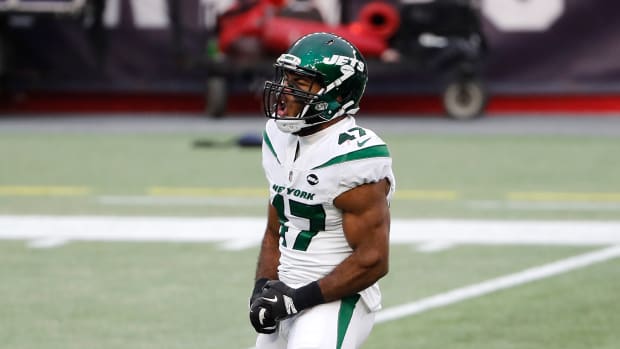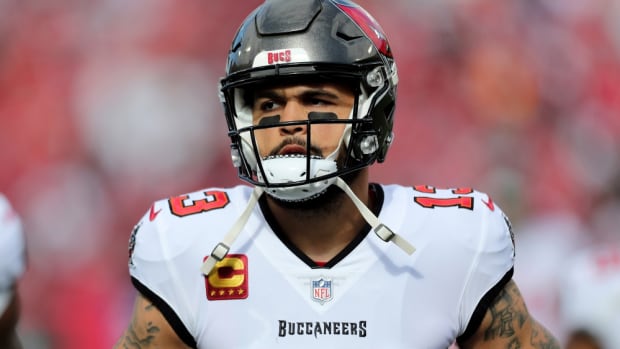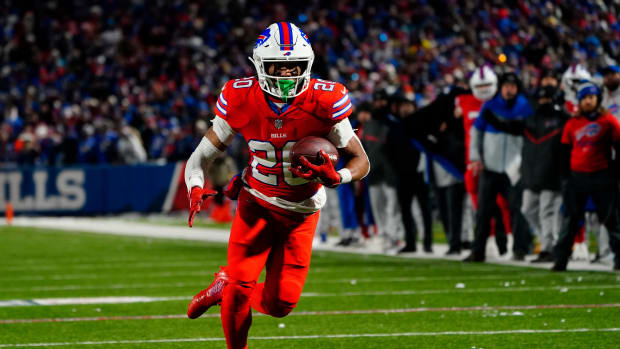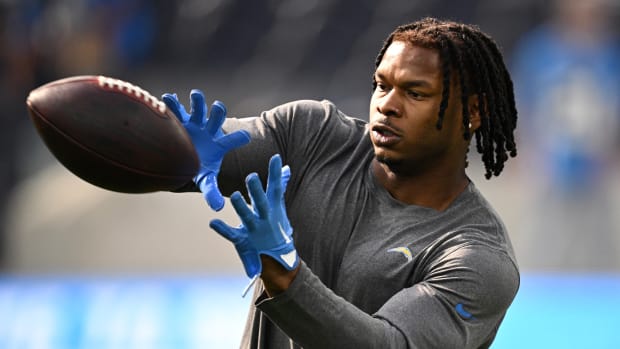Colts Preview: Super Bowl Contenders, as Luck Would Have It
Already established as one of the NFL's top quarterbacks, Andrew Luck is ready to take the Colts into Super Bowl contention. (Andrew Hancock/SI)
Offense
Let’s make one thing clear: the Colts are a serious Super Bowl contender. In a way, it’s simple logic. Last season, they advanced a step further in the playoffs than they did in 2012, falling to the Patriots in the Divisional round. They were never supposed to be there, really. This team originally expected a multiyear rebuilding project when GM Ryan Grigson, head coach Chuck Pagano and quarterback Andrew Luck arrived in 2012. And the 2013 Colts offense was littered with casualties. They reached the second round of the postseason despite season-ending injuries to:
- star wideout Reggie Wayne in Week 7 (ACL)
- starting running back Vick Ballard in a Week 2 practice (ACL)
- new starting running back Ahmad Bradshaw in Week 6 (neck)
- starting H-back Dwayne Allen in Week 1 (hip surgery)
Propelling this battered club was the sheer greatness of its precocious quarterback. Luck is “elite,” as they say, and unquestionably the top young offensive player in the game. He has a Roethlisbergian ability to keep his eyes downfield while shedding defenders off improvised movement; he can make strong, accurate throws from various platforms while under duress; in terms of efficiency, he’s the best mobile young quarterback in the NFL.
Breaking down the mobile QBs: Luck, Griffin, Newton, Wilson and Kaepernick
Luck won’t have to shoulder as heavy a load with the Colts’ lineup healthy again. It’s a better lineup, too, as there’s a new potentially big-time receiving weapon in Hakeem Nicks. Injuries and inconsistency caused Nicks to drop off in his final two years with the Giants. But the sixth-year pro still managed 896 yards last season, and prior to dropping off he was good for about 1,100 yards a year. Nicks is a superb fit for Luck because he has a keen sense for subtle changes in direction towards the end of routes. That creates tight-windowed playmaking opportunities late in the down, which Luck’s game is tailored to capitalize.
If healthy, Hakeem Nicks should mesh nicely with Luck. (AJ Mast/AP)
Luck’s slow transition from being a great quarterback to a legendary one hinges on his ability to command an offense intellectually. He’s shown steady growth over his first two years, taking more responsibility in pre-snap adjustments and audibles. The question this year is: What style of offense should Luck be commanding?
Second-year coordinator Pep Hamilton believes in a traditional, run-oriented, under-center dropback system built on fundamentals and attitude. Few teams today are constructed to play this way, and Hamilton discovered last year that his Colts were no exception.
For starters, the offensive line was not beastly enough to move defenders in the ground game or athletic enough to keep them at bay while pass-blocking for a deep play-action drop. Management saw this coming. Prior to last season, Grigson used a third-round pick on guard Hugh Thornton and a fourth-rounder on center Khaled Holmes. Thornton was the only one who wound up seeing action, turning in an unremarkable rookie performance.
Not trusting the long-term efficacy of his other guards, Grigson used his second-round pick this year on Jack Mewhort, whose playing time on the left side will be determined largely by his ability to execute the man-blocking power and counter runs that Hamilton favors. The hope is that Holmes, the center by default after 26-year-old Phil Costa’s unexpected retirement, can stabilize the rest of the interior. The line’s exterior is stellar but not spectacular; right tackle Gosder Cherilus has slow feet but, as a wise veteran, knows how to compensate, while Anthony Castonzo has the athleticism to be an upper echelon left tackle but must become a notch more consistent.
However the line shakes out, Hamilton’s old school system still needs a power running back. After trading a first-round pick for Trent Richardson last year, the Colts learned what the Browns already knew: the 2012 No. 3 overall pick is simply not a good NFL runner. Richardson has a bad tendency to stop his feet in preparation for contact, he seems to look for where defenders are rather than where they aren’t and he doesn’t have the lateral agility or burst to overcome these faults.
Richardson will get a fair crack at being the feature guy, but come October, don’t be surprised if Bradshaw assumes more of the load—just like Donald Brown did from Richardson down the stretch last season. Ballard showed vastly improved swiftness through the hole in his only game last year; if he can’t muster that again coming off a serious knee injury, Bradshaw, who has the pass-blocking and screen-catching adroitness to be an excellent third-down back, will assume more reps on first and second down.
Bradshaw also gives Hamilton more options for spreading into a modern pass-oriented offense. Hamilton shrewdly did this last December, going with more 3 x 1 sets. That was in part to compensate for a paucity of talent at wideout. One might think a spread approach puts more pressure on wide receivers, but it’s closer to the opposite. When your passing game takes place out of traditional running formations and leans heavily on play-action, you’re counting on receivers to out-position their primary defender early in the route. In a spread, and especially 3 x 1 sets, you can construct intertwined route combinations that give receivers a clean release off the snap, putting them in a position of control by default. Hamilton was great with these concepts last season, using an array of motion-to-stacks, tight three-receiver bunches and redistribution tactics (i.e. having a receiver line up inside and immediately switch to an outside release upon the snap).
Hamilton will keep using these tactics in 2014 because they’re what win games, but he’ll no longer be doing it to compensate for a lack of receiving talent. The ageless Reggie Wayne is expected to regain his old form. With Nicks on the other side, T.Y. Hilton can be more of pure move player from the slot, which best suits his deep ball prowess. Third-round rookie Donte Moncrief can learn the ropes from a less-demanding No. 4 receiver role, assuming he beats out the talented Da’Rick Rogers. At tight end, Coby Fleener has not cultivated the swiftness and fundamental precision to be a potent starter, which is disappointing. But with fellow third-year pro Dwayne Allen back, providing dimension to the position, Fleener could encounter more favorable matchups this year.
The contrasting styles of a run-based scheme versus a pass-based scheme presents choices for Hamilton. The beauty is, with Luck at the helm, he can’t choose wrong.
The Colts defense will have to get by without the services of Robert Mathis for the first four games. (Andrew Hancock/SI)
DEFENSE
Just like the offense, Indy’s defense is back to full strength heading into this season. That doesn’t make it a great unit, though. The Colts have a new starting nose tackle, inside linebacker and new free safety. Those changes, if not fruitful, will leave them alarmingly weak up the middle. The hope would then be for the strengths on the outside— where Grigson and Pagano have emphasized in building their roster—to rise to a pinnacle level. That’s a lot to ask.
Having coached stalwart veterans Haloti Ngata and Cory Redding in Baltimore, Pagano understands the value of versatile defensive linemen in his hybrid 3-4/4-3 scheme. He brought Redding with him to Indy in 2012, and this offseason the Colts signed another ex-Raven, Arthur Jones, a longtime backup who emerged as a compelling penetrator and block-shedder last season. The year before, another noteworthy backup-turned-budding starter was signed in free agency: ex-Niner Ricky Jean-Francois. His first season here was successful though not scintillating. He should be better playing in a three-man rotation this year. No one from the rotation has the size to play nose tackle, however, so the Colts are betting that Josh Chapman can assume a heavier load or that soon-to-be 31-year-old backup Brandon McKinney can bounce back from a year filled with knee problems.
AFC South Deep Dive Previews
Texans: O’Brien Builds Without a QB FULL STORY Jaguars: An Offensive Overhaul and a Sliver of Optimism FULL STORY Titans: Can Defensive Creativity Carry Them? FULL STORY
Behind this defensive line is a linebacking corps with questions. For one: can Bjoern Werner fill the suspended Robert Mathis’s shoes the first four weeks? Werner, a 2013 first-round pick, struggled in setting the edge last season and did not flash much on passing downs. Neither did overpriced 2013 free agent Erik Walden.
Another question: where will the strength emerge at inside linebacker? Not “strength” as in “strong suit,” strength as in actual physical strength. Incumbent starter Jerrell Freeman, who must be steadier in his reads, is a weak-side player, where he can rely on speed and swiftness. Free-agent pickup D’Qwell Jackson is someone who absolutely must be kept clean. So who takes on blockers? With the best player on the bench being undrafted second-year nickel man Josh McNary, the Colts’ most physical second-level run stopping may actually be high-octane strong safety LaRon Landry.
Landry will split time between the box and the secondary, where Pagano prefers to play man coverage concepts—both presses and off-coverage, read-and-react techniques (like quarters coverage). He has one outstanding resource in Vontae Davis, a physical jammer, willing tackler and savvy pass sniffer. Davis’s aggression, however, inevitably will come with a few costly miscalculations and physical defeats, which is why he can’t be considered top echelon and why the Colts defensive backfield won’t be impermeable on their stoutest side of the field. Overall, though, Davis makes far more plays than he gives up.
Opposite Davis, Greg Toler must stay healthy lest the Colts rely on journeyman Josh Gordy again. Nickelback Darius Butler is capable of surviving as a base package starter on the outside, if need be, though he’s most comfortable in the slot. Considering that he finally started showing the talent that prompted the Patriots to draft him 41st overall in 2009, it’d be wise to have Butler specialize in his area of strength. What really makes it important for that cornerback group to step up even more in man coverage is the downgrade at safety. Two-time Pro Bowler Antoine Bethea is gone; in his stead is Mike Adams, another smart, versatile player but one equipped with only backup caliber physical attributes.
SPECIAL TEAMS
Adam Vinatieri is still Adam Vinatieri. At 41, he’s shown very little decline in range. Punter Pat McAfee has one of the best legs in the game. Kick return duties will be assigned after training camp. T.Y. Hilton figures to remain the punt returner even though he was not particularly dynamic here last year.
BOTTOM LINE
Mediocrity up the middle and lack of depth are significant concerns on defense. But outweighing them are the pluses of an offense that’s led by a superstar QB and is ripe with weapons at the other skill positions. Anything short of an AFC Championship Game appearance can be considered a disappointment.









































